“It was in the night, we didn’t see them coming. There was a guy who came in the house, and everybody without disabilities they decided to run off, leaving the place, [but] I couldn’t run.”
Twenty-year-old Cathy Mek speaks in barely more than a whisper. She’s sitting on a thin bamboo bench in a quiet, private clearing above her village of Wapena, in the highlands of Papua New Guinea.
It’s a region known for inter-tribal violence as much as stunning scenery and Wapena – perched on a hill overlooking the tidy crops and lush valleys of Western Highlands province – is no exception for either. But rape, indiscriminate destruction and automatic weapons are changing the face of traditional conflict, and PNG authorities and international non-governmental associations are struggling to get a handle on the deteriorating situation.
On 28 June, the people of Wapena were attacked by a neighbouring tribe over political differences during the national election.
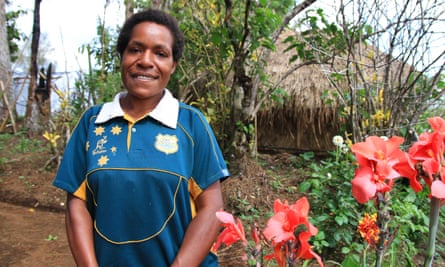
The village’s men were at a counting station in a nearby town. Able-bodied women grabbed their children and fled. Mek, who has a permanently injured foot and deformities in both hands, could not.
“They put a knife to me, they took me out and raped me,” Mek says. “I refused, I argued, but they slept here and ate here and then they continued on.
“After that I started screaming. I was still screaming until a fellow from the other village heard my screams and came into rescue, and other people … came and helped me out.”
Mek’s mother, Elisabeth Yong, and Wapena’s leader, Jerry Rombena, sit with us. As Mek talks Rombena, a former police officer, silently shakes his head in anger and sadness. He says the police know the who the rapists are but won’t make an arrest unless the men leave tribal land, for fear of triggering another battle. Justice for Mek is unlikely.
She suspects the other women feel guilty for leaving her behind but says no one is helping her to overcome the trauma. “I am calling out for help but they don’t want to help.”
Near a collection of huts covered in Red Cross tarpaulins, Mek’s fellow villagers share their stories of 28 June. They gather under the shade of a tree on the edge of the hillcrest, cradling children and phones and machetes. No one mentions Mek.
Asked to raise a hand if their house was destroyed in the attack, nearly everyone does so.
“They came from the other side of the creek,” Rombena recalls. “They walked, they came in groups with all the clansmen, with weapons like bows and arrows and high-powered ammunition.
“We saw them coming from the other side, with their weapons and shouting,” says Susan Dupi, pointing across a field to the one dirt road in.
“They burned the first place there, and we saw them coming in large groups so we decided to run with our children. We went to the other side [of the village]. They didn’t find us.”
As well as assaulting Mek, the attackers burned down 36 homes, slaughtered 32 pigs and destroyed the grain stores, gardens and cash crops, says Gus Kasyaki.
‘Out of control’
Wapena was luckier than many villages in that the attackers brandished their military-grade assault weapons, but did not shoot anyone.
Guns are now a common feature of the increasingly violent tribal fighting, replacing traditional bows and arrows. The region’s extensive stock of high-powered guns are believed to come from over the border, in Indonesian West Papua, illegally traded for PNG-grown marijuana. Some say they can also be bought from police and soldiers.
Marijuana “grows like wildfire” in the highlands regions, and the black-market trade of weapons, including M16s, AK-47s and explosives, has often left police officers outgunned, says the acting provincial police commander for Enga, Epenese Nili.
In a documentary produced by the Red Cross this year, the former PNG defence force commander Jerry Singirok says the use of weapons in the highlands is “out of control”.
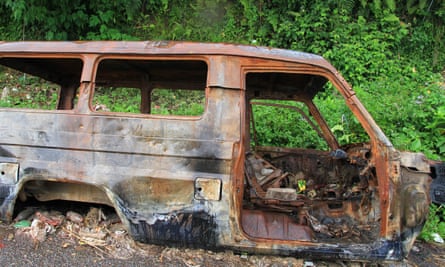
“That’s where 80% of the population of Papua New Guineans live. We know for a fact that every tribal fight guns are used, every roadblock guns are used, every murder guns are used, and we know that during elections guns are used to intimidate, to harass, even to murder opposing people, and we are very concerned.”
Last week 11 men were shot dead in a dawn raid on a village in the Eastern Highlands region, the Post-Courier reported. About 30 people were reported to have been killed in election-related violence this year, the worst of which was in Wabag, Enga province, where the dead included two police officers killed outside a hotel.
Hundreds of security forces were deployed to Wabag to control the violence after the contentious defeat of the former opposition leader Don Polye. On the outskirts of town a burnt-out ambulance rusts by the side of the road. More than 120 homes in the electorate were reported to have been destroyed.
“We called troops to move in and camped out in the middle between two warring tribes,” Nili says of the Wabag violence. “Police from day one are still camping there now.”
Nili says the groups agreed to lay down their arms, but during an amnesty they surrendered only homemade weapons, keeping the rest.
“We saw those guns in the battlefield,” says Nili, shrugging. “We have search powers to go and search the premises, but somebody has to come and complain, give us the intel report about a particular house having a high-powered weapon. But who is going to come and talk to police?”
The International Committee of the Red Cross, based in Mount Hagen, says it mostly sees homemade weapons during its fieldwork in the region. For this reason the organisation uses plastic rather than metal pipes when it builds water facilities in villages. But the Red Cross head of office for Mount Hagen, Kakhaber Khasaia, says the high-powered guns are a problem.
“When you talk to the tribal leaders they’ll often mention that those guns are owned by young people who are not really controlled by the leaders, who think they are now the most powerful person, they don’t have much experience and they create problems,” Khasaia says.
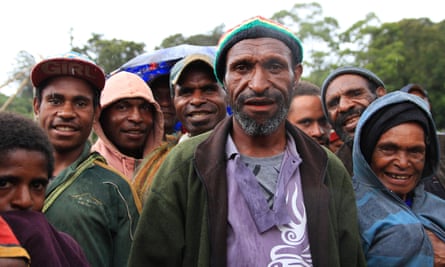
‘A lot of lives lost’
Uma, in Southern Highlands province, is surrounded by groups at conflict with one another. The community leader, Jeffrey Amandi, who, other villagers are proud to note, is a Muslim leader in a predominantly Christian country, says the violence was at its worst in 2010-12.
“A lot of lives lost, a lot of damage, as well as bombs being used,” he says. “I don’t know how the guns come but there is a market somewhere in Papua New Guinea, so we trade.
“We take them for marijuana and then use them for tribal fights.”
Asked if his people too had traded drugs for weapons, Amandi only notes they were “the very first people to become like a superpower in this area”.
“But we said, fighting, OK, we experienced very much and it’s not good [so] we better give up with weapons and have peace, become advocates of peace.”
Traditionally, tribal conflict followed rules that spared women, children, religious figures, health workers and community facilities.
“[Now you can] hear someone say, ‘When we are fighting we don’t even want to see a chicken walking,’” says Janet Nakadi Angelei, a Red Cross field delegate.
A local employee adds: “Nowadays in a tribal fight, fighters target everyone and everything on enemy territory and want to bring maximum damage to the enemy community.”
Children – future enemies – are killed. So are health workers, who treat the enemy. Fighters no longer fear the wrath of God when they gun down a pastor.
Khasaia says neutral people are still largely respected because tribal conflicts are still expected to be resolved in traditional ways, and that requires a peacemaker.
“But … with the new weapons, with new technology like phones, they can organise and mobilise large groups much faster than before, and with cars they can attack faster than before.”
A traditional system of peacemaking and compensation after conflicts remains in place, usually comprising cash and pigs, but with more deaths and damage the unaffordable payments can now force entire clan groups from their land.
Conflict in Kagua-Erave escalated to such an extent in 2013 that hundreds of people were reportedly displaced, and an unconfirmed grenade attack on a safe house which contained mainly women and children killed up to 35 people – one of the worst episodes of tribal violence yet.
The ICRC assists those affected by conflict across a number of provinces, beginning in the Southern Highlands in 2012. Tribal fighting “has a few causes”, says Angelei, the most common of which is land disputes, but it can also escalate from resource access issues, accusations of sorcery, adultery or jealousy.
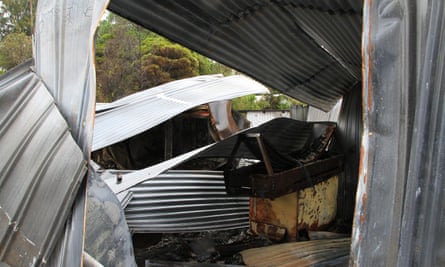
Stories abound of murders and multiple killings sparked by extremely trivial disputes. The clan war sprung from family disapproval of a teenage relationship, the dozen killed after a drunken brawl escalated, the threats of rocket launchers by disgruntled landowners unhappy with resource deals, arrows in eye sockets after an assault at a local market. In Wapena villagers were attacked over an accusation of vote tampering.
“Often the trigger is quite small but has big consequences,” Angelei says.
“The warlords are hunting their enemies, hunting them down,” a former mayor of Tari told Radio NZ after a man was killed in Hela province. “They’re driving around and shooting down people, killing people just like nobody’s business.”
‘We want to stop the suffering’
The ICRC works with communities to re-establish traditional “fighters rules” and discourage the goal of “maximum damage”, while also helping people in the aftermath of violence.
Community representatives are brought together in peacetime to discuss and propose rules for future conflicts. The rules are taken to district governments for potential legislation, before being disseminated among the population.
Provinces are at different stages of progress but Khasaia says people are responding positively to the idea of everyone returning to traditional rules of engagement.
“At least if fighters understand and respect those rules it will reduce the number of women raped, children killed, disabled killed, healthcare facilities destroyed, houses burned,” he says.
The Red Cross helps provide materials to rebuild burned homes and cooking and farming equipment for families whose houses have been looted. In one village, new guttering and tanks collect rainwater so women and girls do not have to travel to a river where a rival village would often attack them.
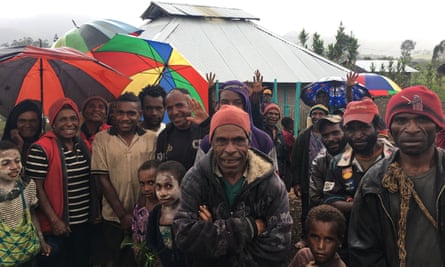
At the end of the conflict near Uma a peace deal was brokered and the ICRC agreed to build a new health clinic. The clinic is staffed by four local nurses and cares for about 45,000 people from the surround district, Amandi says. The simple structure, built in part from “bush materials”, has not been targeted for five years and will now be replaced by a larger and better equipped facility.
Wapena is rebuilding, and the people there say they have no plans to retaliate. They are still living under tarpaulins because there is none of the long grass they need to make their traditional roofs.
Red Cross officers say there is only so much they can do.
“We don’t have the illusion that we’ll stop the conflict, we don’t have the mandate to stop the conflict,” Khasaia says. “But we want to stop the suffering of individuals who are not part of the conflict.”
